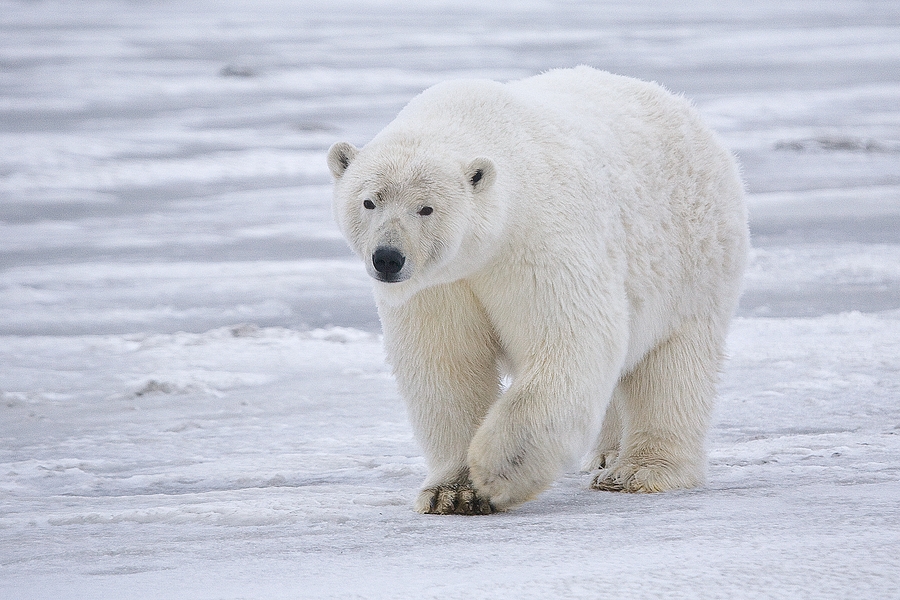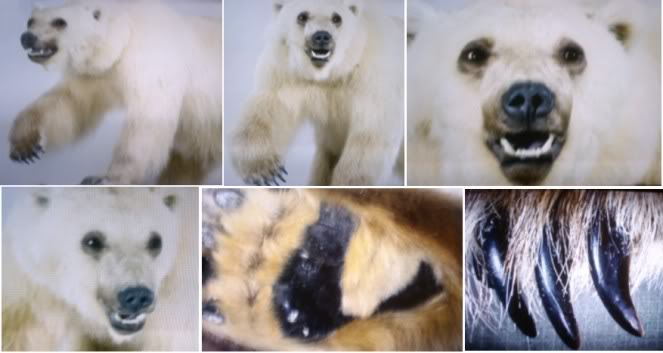 It’s amazing what scientists can do nowadays. They can get right down into the center of an atom. They can tell us in detail about rocks on other planets. So it’s no wonder when they report there are a certain number of very large animals in an area – and they only have to count up to a thousand or two – we tend to believe the number is pretty close. Population surveys for polar bears, for example, sound a bit like taking the census, only the bears don’t have phones.
It’s amazing what scientists can do nowadays. They can get right down into the center of an atom. They can tell us in detail about rocks on other planets. So it’s no wonder when they report there are a certain number of very large animals in an area – and they only have to count up to a thousand or two – we tend to believe the number is pretty close. Population surveys for polar bears, for example, sound a bit like taking the census, only the bears don’t have phones.
In reality, counting white animals against a white backdrop from a helicopter, over hundreds of thousands of square kilometers, is actually pretty tricky. Ditto caribou against the tundra. It’s also really expensive, so when a survey is done, those numbers have to be used for a decade or two, in combination with other measures, to estimate the health of a population.
When an August 2011 survey of Hudson Bay’s 8000km western coastline found 1,013 bears – 66% higher than the extrapolated estimates that had led to endangered status and trade moratoria on bear parts in the EU and US –the results were met with incredulity. The numbers confirmed reports from the Hunter and Trapper Associations in the area who have consistently seen more bears, but have been discredited by their immediate financial interest in raised hunting quotas.
Every year, about 450 foreign hunters each pay around $50,000 for a tag to shoot a polar bear, accompanied by an Inuit guide. For the North American Super Slam, and other large animal lists that prescribe the hunter’s complete trophy room, a dead polar bear is de rigeur. In China and Russia, a polar bear pelt can fetch $15,000. (You may be thinking laws against this would be wise regardless of bear population numbers, and you would not be alone.)
But for environmental scientists, Government of Nunavut wildlife management director Drikus Gissing might as well have been the Iraqi Minister of Information for all that his announcement, with its sweeping conclusions, was accepted. For one thing, it was derived from a range between 717 bears and 1430 bears. This alone tells us something about the range of error in this line of work. Animal counts had become too politicized to be taken on face value. In the end, when it’s one culture’s word against another’s, the more powerful group is often seen as right. Yes, even in science.
So the helicopters are back at it this year, this time along Baffin Bay, which hasn’t seen a polar bear survey since the 1990s. But this time as they follow the tracks and swoop down low, they are trying something new. Rather than the invasive and time-consuming bear handling involved in physically tagging a bear, wildlife officers are biopsy darting every bear they see. The dart, shot from a rifle, hits the bear and falls away with a little piece of flesh attached. Hundreds have already been collected and DNA will be analyzed next fall to estimate population size.
Most of the world’s 25,000 or so polar bears live in Canada, and they’ve become the symbol of climate change. As apex predators, they accumulate obscene amounts of the mercury we’ve been releasing, and their habitat is changing rapidly. While it will be important to establish whether this has already resulted in fewer bears – the numbers of cubs and yearlings seems to be down, even in last year’s otherwise heartening survey – we can see in other ways that the existing bears are under stress.
One such sign is the emergence of a new creature in the polar bear’s range, first spotted in the wild in 2006 near Sachs Harbour, Northwest Territories. It’s got a long neck like a polar bear, but it’s smaller. It lies and behaves like a polar bear, but it has shoulder humps. The new creature has hairy paw soles like a polar bear, but its hair is mostly solid, with only patches of hollow hair.
 As caribou migration routes have moved North, grizzlies have followed and started mating with polar bears. Not only have they produced hybrid young, but those young are fertile. Polar bears and grizzlies only diverged about 150,000 years ago and haven’t developed many genetic differences, despite quite dramatic visual dissimilarities. Second-generation hybrids have now been confirmed in the wild. There have been a dozen sightings in only a handful of years, mostly by hunters, and most of those bears were identified after they were shot. It’s also a legal problem, in that you can’t shoot a grizzly with a polar bear license.
As caribou migration routes have moved North, grizzlies have followed and started mating with polar bears. Not only have they produced hybrid young, but those young are fertile. Polar bears and grizzlies only diverged about 150,000 years ago and haven’t developed many genetic differences, despite quite dramatic visual dissimilarities. Second-generation hybrids have now been confirmed in the wild. There have been a dozen sightings in only a handful of years, mostly by hunters, and most of those bears were identified after they were shot. It’s also a legal problem, in that you can’t shoot a grizzly with a polar bear license.
Grolar bears, or pizzlies – I know, shudder – bring out the excitement of cryptozoology (Big Foot and the Loch Ness monster), but they’re very real. There has been a suggestion of combining Inuit words for ‘polar bear’ and ‘grizzly’ (nanuk and aklak) to call the new bears nanulak, but that just transfers the cringe-effect to Inuktitut speakers. I find myself scouring the photos, trying to tease out both species’ features in them, like a father staring intently at the faces of his children, looking for familial likenesses and possibly proof of paternity. What I end up seeing, in this quintessentially 21st century creature, is a glimpse of the future. Closely related marine mammals from the North Atlantic and the North Pacific are about to merge territories, and we’re likely to see more hybridizing in the years to come.
The divergence between polar bears and grizzlies for non-mitochondrial DNA is far older than 150kya, so the two species have experienced habitat changes from multiple interglacials.
The species divergence survived previous warmings, but the speed and potential severity of the current one could have a different outcome.
Not unlike when Homo sapiens moved into the territory of Homo neanderthalensis… hybrids ensued.
Not much left in the way of Neanderthal genes in most of us (between 1–> 4% by current estimates). Except that colleague of yours you don’t like. He or she probably has 10%…
At #3 is the DNA still present in populations that didn’t live with Neanderthals? (That is, non European populations?)
Also I’ve heard that the light colored hair genes are from Neanderthals. Don’t know if that’s true.
According to recent research, inhabitants of northern Africa and all other continents have Neanderthal DNA. Only inhabitants of equatorial and southern Africa do not have it.
By the way, the more precise denominations for us and our Neanderthal brothers are Homo sapiens sapiens and Homo sapiens neanderthalensis. We belong to the same species Homo sapiens, as the interbreeding proves.
This is not something new. I’ve known this for a very long time. Even as a child. They’ve been interbreeding since forever. Stop with the alarmism.
If that’s the case, “alarmist” is a big word for your age — the first hybrid of this nature was documented at a German zoo in 2004.
Of course we have Neanderthal genes, take a look at the Springbok Front Row* (or the English front row for that matter) and you can see for yourself. They possess all the anatomical features of the Neanderthal.
* The front row are the 3 ‘large’ forwards that make up the Scrum in Rugby Union.
A friend of mine actually used this as an example of proof in exam (as a joke) and got full marks- nice to see an examiner with a sense of humour!